
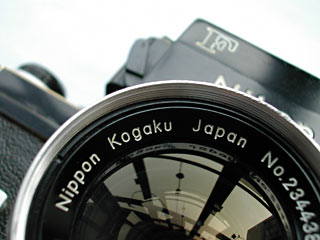
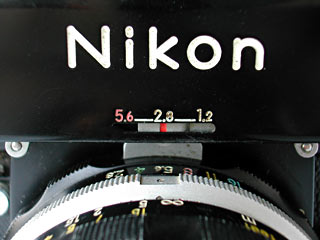
|
Just A Turning Point
With the release of Nikon F6 under the quote - 'The ultimate in film SLR evolution', the latest flagship professional SLR for 35mm photography in 2004, is it controversial whether this wording ('ultimate' ?) has symbolized the dead end of 35mm film based photography ? Anyway, it is a good time to look back how the evolution of Nikon F series sparked off in 1959, with the first camera in the series, Nikon F released to the market for 35mm professional photography.
Nowadays, it is very common in layman's term, that 'professional camera' equals to SLR (Single Lens Reflex). No matter how true this statement is, at least for the phenomenon that layman interpreting 'professional camera' this way, that was not quite common in 50's or before. Leica M series rangefinder had dominated the field of 35mm professional camera for decades, until Nikon F was released in 1959.
Before that, SLR caused inconvenience because of viewing at non-maximum aperture and no automatic self-returning mirror. These factors created extra hindrance to photographers in working with a SLR, such that viewfinder was dim due to reduced aperture for shooting (or need to go to and fro between maximum aperture for viewing and reduced aperture for shooting), and even totally dark after shutter fired, and until mirror flipped to viewing position again with film advancing. It made SLR not welcomed by photojournalists or press photographers, when the moment of capture is precious. Before that rangefinder proofed its high performance for doing these jobs well, but there were still other fields in professional photography to be filled in. Macro and tele photography were not fully facilitated in using rangefinder.
Nikon F Story
Nikon Engineers once showed their talent in managing the developing of their important rangefinder SP/S3 (continuation of the RF series - S1, S2) and the new Nikon F in parallel. We can see some parts of their bodies (film advance crank, film counter, film rewind lever, shutter speed dial, camera back) are very similar, so I predict that the manufacturing process or even some parts are shared. It was an important step to speed up the development of a ground breaking new camera, Nikon F.
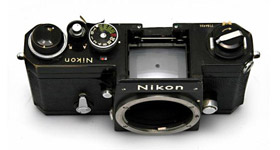
It proofed its success in realizing the benefit of such a modern SLR design in Nikon F, although some other brands incoporated some of the similar SLR design, but did not create the big influence in professional photography. Auto-diapharm removed the trouble in dealing with maximum and reduced aperture for viewing and shooting. Automatic self-returning mirror enabled photographers to keep watching the scene with the reflex mirror flipping and shutter curtain travelling, all completed in a fraction of a second.
When viewing and flim exposure falling on the same path, this 'what you see is what you get' mechanism ensured accurate focusing and framing inside the viewfinder, which will be exposed on film. Hence, it solved the headache in macro and tele photography.
With the modern professional SLR design in mind, it was a complete 'system', rather than a camera plus some lenses. Nikon produced tremendous range of accessories to suit different photography need, although the demand of some particular items might be very minimum. Professionals were sure that their investment on Nikon F system was extendible, as they could equip it with the correct accessory later to finish other kind of job requirement they had not thought of. Flexibility is emphasized by using modular design, so that different options to combine the bits and pieces, to name a few :
- interchangeable viewfinder (eye level prism, meter prism, waist level finder, action finder, magnifying finder)
- different kinds of focusing screen can be installed easily
- lens lineup from 21mm to 1000mm, some telephoto lenses are from Nikon RF series, mounted via NF adapter
- detachable camera back is interchangeable with Motor Drive backs, in order to support continuous shooting. F36 and F250 are 2 motor models to support shooting in 36 and 250 exposures respectively.
At the end, Nikon F obtained worldwide acceptance in 35mm professional photography, and it was the first time a Japanese brand to dominate in photography market, as in the past they were all Germany brands' territory. It declared the maturity of the Japanese photo industry.
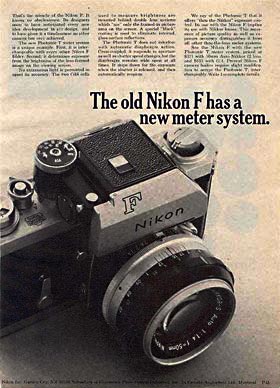
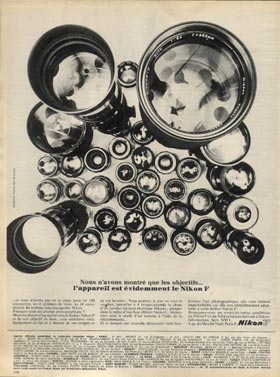
In Vietnam War
Vietnam War was not only a war, but also a testing field to make Nikon F legendary. The manufacturing standard, high precision and robustness made it capable in being hand it hand with photojournalists to complete the job well under extreme condition. It was sometimes quoted as the 'indestructible camera'.
|
Larry Burrows - ( Biography ) a British war photographer worked for LIFE Magazine, featured a story in Vietname War with title 'With A Brave Crew In A Deadly Fight' in April 1965 issue. An image is showing him installing his camera on a fixture extended from the helicopter. I believe that such camera was Nikon F with meterless eyelevel finder (triangular top) and motor, such that he could stay inside the cabin safely, to trigger the motor and shutter via a cable. Such equipment setting is a very clever design. There was another camera hanging by neckstrap on the front of his body, very likely another Nikon F. (see the images at the bottom)
'As Yankee Papa 13 approaches the landing zone, Farley open fires with his M-60 machine gun at Vietcong positions. Burrows took this picture with a camera mounted outside the copter on a special rig attached to the gun. As the gun swiveled, so did the rig, thus keeping the camera always pointed directly at Farley. Burrows triggered the camera by remote cable while squatting out of sight behind Farley.'
Finally, Larry Burrows died during a helicopter crash in Laos in 1971.
|
|
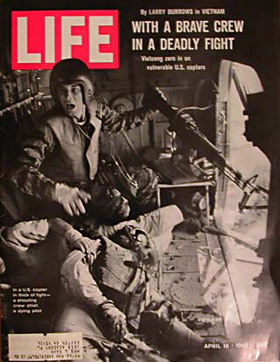
About The Camera
The camera shown in this webpage is my Nikon photomic FTn purchased via ebay.
- Nikon F body, supporting shutter speed 1/1000 - 1sec, plus B and T setting.
- with Nikon F bayonet mount, lens available with various focal length
- with self-timer, depth-of-field preview button and mirror locking up feature
- hot shoe for external flash attachment is not the modern common one, but it can be be converted to modern one via the adapter AS-1, for attaching modern flash or other accessory, e.g. external finder for 6mm and 10mm fisheye lens, where mirror is in lock up position, and viewing through prism/meter finder is not possible
- FTn meter finder, supporting ISO 6 - 6400. Shutter speed is visible in the finder. Meter needle is visible in the finder and in the mini window on the top of the finder housing (I guess, probably to facilitate waist level shooting)
- Nippon Kogaku Nikkor-S Auto 35mm / F2.8. They are the pre AI or non AI type lens, with metering prong to match with meter finder to synchronize aperture setting in metering. These old type lens can be converted to AI type by Nikon cusomer service or in professional repair shop
- Pistol Grip (shutter release cable can be attached for normal shooting, or electric cable for triggerring the motor drive back)
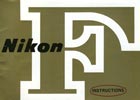 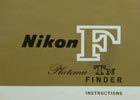
More Information
Bottom Photo - (1) & (2) LIFE magazine of April 1965 (3) Nikon F with Nippon Kogaku 50mm F/1.4, Photomic FTn Meter Finder & F36 Motor
|

